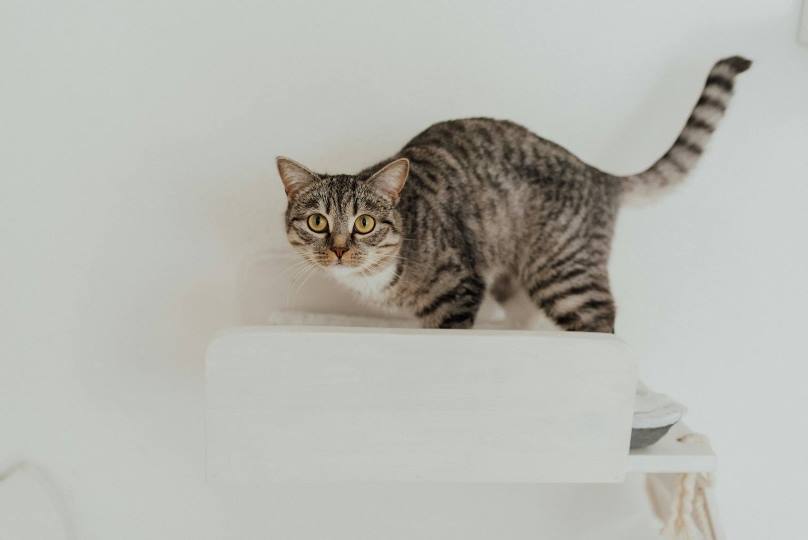In this Article
Training your cat to use wall shelves can transform your home into a feline-friendly environment that provides enrichment, exercise, and a safe space for your pet. Cats naturally love vertical spaces, mimicking the trees and high perches their wild ancestors used for safety and observation. But not all cats instinctively gravitate to wall shelves, especially if they're new to your home or the shelves are newly installed. This expert guide offers a comprehensive, step-by-step approach to helping your cat confidently navigate and enjoy wall shelving. With patience, positive reinforcement, and a little creativity, you can create a stimulating vertical playground for your feline friend.
Why Wall Shelving is Great for Cats
Before diving into the training process, it's worth understanding why wall shelves are beneficial for cats:
- Enrichment and exercise: Vertical spaces encourage climbing and jumping, keeping your cat physically active and mentally stimulated.
- Safe Territory: Tall perches give cats a sense of security and allow them to observe their surroundings without feeling threatened.
- Space Saving: In small homes or apartments, wall racks maximize space by creating a vertical playground without cluttering the floor.
- Stress Reduction: Elevated areas can reduce conflict in multi-cat households by giving each cat its own territory.
With these benefits in mind, let's explore how you can train your cat to climb wall shelves.
Step-by-step guide to training your cat
Step 1: Choose the right shelves and placement
The first step is to make sure your wall shelves are cat-friendly and strategically placed. Cats won't use shelves that feel unsafe or inaccessible.
- Choose sturdy shelves: Choose shelves that can support your cat's weight (typically 10-20 pounds, depending on breed). Make sure they are securely fastened to the wall with appropriate hardware.
- Add traction: Cover shelves with non-slip materials such as carpet, sisal, or textured matting to prevent slipping. Cats need a non-slip surface to feel safe when jumping.
- Plan the layout: Arrange the shelves to create a logical "pathway" for your cat. Space them 12-18 inches apart vertically and horizontally to accommodate your cat's jumping ability. Include a mix of perches, tunnels, and platforms for variety.
- Choose a quiet location: Place shelves in a low-traffic area where your cat will feel safe. Avoid places near loud appliances or busy doorways.
- Start low: For beginner cats, install the first shelf close to the ground (about 1-2 feet high) to build confidence before introducing higher perches.
Once the perches are installed, inspect them for stability and safety. Wobbly or slippery surfaces will discourage your cat from using them.
Step 2: Familiarize your cat with the shelves
Cats are naturally cautious, so introducing the shelves gradually is key to building trust.
- Let her explore: Allow your cat to explore the shelves at her own pace. Avoid forcing her onto the shelves as this can create negative associations.
- Scent Marking: Rub a soft cloth on your cat's cheeks to collect her pheromones, then wipe it on the shelves. Familiar scents make the shelves feel like part of her territory.
- Place familiar items: Place a favorite blanket, toy, or bed on the bottom shelf to make it inviting. Familiar items signal that the shelf is a safe, comfortable place.
- Observe behavior: Observe how your cat reacts to the shelves. If they show curiosity (sniffing, pawing, or jumping), you're off to a good start. If they seem hesitant, proceed slowly.
This step may take several days or even weeks, depending on your cat's personality. Shy or older cats may need more time to become comfortable.
Step 3: Use Positive Reinforcement
Positive reinforcement is the foundation of cat training. By rewarding your cat for interacting with the shelves, you'll encourage her to use them regularly.
- Treats and Praise: Keep high-value treats (such as freeze-dried chicken or tuna) handy. When your cat approaches, touches, or jumps onto the lowest shelf, immediately offer a treat and verbal praise. Use a happy tone to reinforce the positive experience.
- Clicker Training (Optional): If you're familiar with clicker training, use a clicker to mark the exact moment your cat interacts with the shelf, followed by a treat. This will help your cat associate the shelf with rewards.
- Gradual Progression: Once your cat is comfortable on the lowest shelf, place treats on slightly higher shelves to encourage exploration. Avoid placing treats too high too soon, as this may overwhelm her.
- Consistency: Practice short training sessions (5-10 minutes) every day. Cats have short attention spans, so keep the sessions fun and stress-free.
Avoid punishing or scolding your cat for not using the shelves. Negative reinforcement can make them anxious and less likely to try again.
Step 4: Encourage jumping and climbing
Once your cat is comfortable on the lower shelves, it's time to encourage her to climb and jump to higher perches.
- Demonstrate the path: Use a laser pointer or feather wand to guide your cat along the shelf path. Slowly move the toy from one shelf to the next to encourage her to follow.
- Reward each step: Place treats or toys on each shelf as your cat progresses. For example, if she jumps from the floor to the first shelf, reward her before encouraging her to go to the next one.
- Adjust for ability: If your cat has difficulty reaching a shelf, adjust the spacing or add an intermediate platform. Older cats or those with mobility issues may need ramps or lower jumps.
- Shelf Play: Encourage your cat to play on the shelves by dangling toys or tossing light balls. This will make the shelves a fun destination rather than just a perch.
Be patient, as it may take some cats weeks to confidently navigate the entire shelf system. Celebrate small milestones to keep the process positive.
Step 5: Make the shelves a destination
To ensure that your cat continues to use the shelves, make them a desirable place to hang out.
- Add comfort: Place cozy beds, blankets, or catnip toys on the shelves to make them inviting. Rotate items regularly to keep things interesting.
- Create a view: Place shelves near a window (if safe) so your cat can watch birds or outdoor activities. Cats love to observe their surroundings from a high vantage point.
- Feeding Stations: For confident cats, place a small portion of their food or water on a shelf to encourage regular visits. Make sure the shelf is wide enough to prevent spills.
- Scratching Posts: Incorporate a scratching post or sisal-covered shelf to satisfy your cat's scratching instinct. This also reinforces the shelves as part of her territory.
By making the shelves a rewarding destination, your cat will naturally gravitate toward them.
Step 6: Maintain and Expand the System
Once your cat is using the shelves regularly, you will want to maintain their interest and ensure long-term safety.
- Regular inspections: Inspect shelves monthly for loose screws, worn surfaces, or other hazards. Replace slip-resistant coatings as needed.
- Cleanliness: Wipe down shelves to remove fur, dust, or spills. Use pet-safe cleaning products to avoid irritating your cat.
- Expand Gradually: If your cat loves the shelves, consider adding new perches, tunnels, or bridges to keep the system interesting. Introduce changes slowly to avoid overwhelming her.
- Monitor behavior: If your cat suddenly stops using the shelves, it could indicate stress, health problems, or discomfort. Consult a veterinarian if you notice any changes in behavior.
With proper care, your Wall Shelves can be a favorite place for years to come.
Troubleshooting Common Challenges
Even with careful training, you may encounter obstacles. Here are solutions to common problems:
- Cat Refuses to Use Shelves: If your cat avoids the shelves entirely, revisit step 2 and focus on building familiarity. Try different treats or toys to stimulate interest. Make sure the shelves are stable and accessible.
- Cat falls or slips: If your cat is slipping, check the shelf surface for traction. Add carpet or mats and lower the shelf height until she regains her footing.
- Multi-cat conflicts: In multi-cat households, some cats may guard the shelves. Provide multiple avenues and perches to reduce competition. Use pheromone dispensers to reduce tension.
- Older or disabled cats: For cats with mobility issues, use wider shelves, lower heights, and ramps. Consult a veterinarian for advice on supporting their physical needs.
Tips for Success
- Know Your Cat: Tailor training to your cat's personality. Confident cats may progress quickly, while shy cats may need extra patience.
- Be patient: Training takes time, especially with timid or older cats. Avoid rushing the process.
- Stay Positive: Keep training sessions fun and rewarding for both you and your cat.
- Consult an Expert: If you're struggling, consider consulting a feline behaviorist for personalized advice.
The bottom line
Training your cat to use wall shelves is a rewarding process that will improve her quality of life and strengthen your bond. By choosing the right shelves, introducing them gradually, and using positive reinforcement, you can create a vertical playground that your cat will love. With patience and consistency, even the most timid feline can become a confident shelf explorer. Start today and watch your cat soar to new heights - literally!

